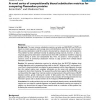982 search results - page 186 / 197 » Potential-Based Hierarchical Clustering |
BMCBI
2010
13 years 7 months ago
2010
Background: Machine learning techniques have shown to improve bacterial species classification based on fatty acid methyl ester (FAME) data. Nonetheless, FAME analysis has a limit...
BMCBI
2010
13 years 7 months ago
2010
Background: As the size of the known human interactome grows, biologists increasingly rely on computational tools to identify patterns that represent protein complexes and pathway...
BMCBI
2008
13 years 7 months ago
2008
Background: The most common substitution matrices currently used (BLOSUM and PAM) are based on protein sequences with average amino acid distributions, thus they do not represent ...
BMCBI
2007
13 years 7 months ago
2007
Background: Protein-protein interactions are critical for cellular functions. Recently developed computational approaches for predicting protein-protein interactions utilize co-ev...
BMCBI
2008
13 years 7 months ago
2008
Background: Formal classification of a large collection of protein structures aids the understanding of evolutionary relationships among them. Classifications involving manual ste...

